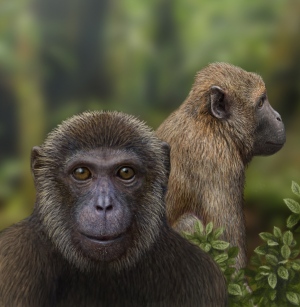By Karl Leif Bates
A newly discovered 25 million-year-old monkey fossil has been named for Gregg Gunnell, director of the Duke Lemur Center’s Division of Fossil Primates.
The thing is, Nsungwepithecus gunnelli, might turn out to be a pig. “It might be a ‘porky-pithecus,’ ” Gunnell said with a laugh. “Early monkeys and early pigs looked remarkably alike.”
The fossil, from southwestern Tanzania, consists of a single molar. But it displays nine characteristics that would distinguish it from other Old World monkeys, according to Nancy Stevens, a paleontologist at Ohio University in Athens, Ohio who was the lead author on a paper about the discovery in Nature.
Gunnell’s monkey was found at a site in the Rukwa Rift Basin along with another new monkey fossil, Rukwapithecus fleaglei, for which scientists have a jaw and three teeth. It too has nine distinguishing features.

An artist’s conception of the two newly named 25.2 million year old fossil monkeys described in Nature. Gregg Gunnell is the guy on the right. (credit: Mauricio Anton)
Gunnell said Stevens named the monkey after him to honor his role in helping her become a paleontologist. When Stevens was an undergraduate at Michigan State University, and Gunnell worked in the museum at the University of Michigan, he took Stevens and her now-husband and co-author Patrick O’Connor along on archaeological digs in Wyoming. Apparently the lessons stuck.
N. gunnelli is actually Gunnell’s third species. He was earlier honored by the naming of a bat and an extinct tillodont, which was, he reluctantly explains, a rather pig-like little animal.
“I’m hoping that this pig really is a monkey — that’ll improve my self-image,” he said.

